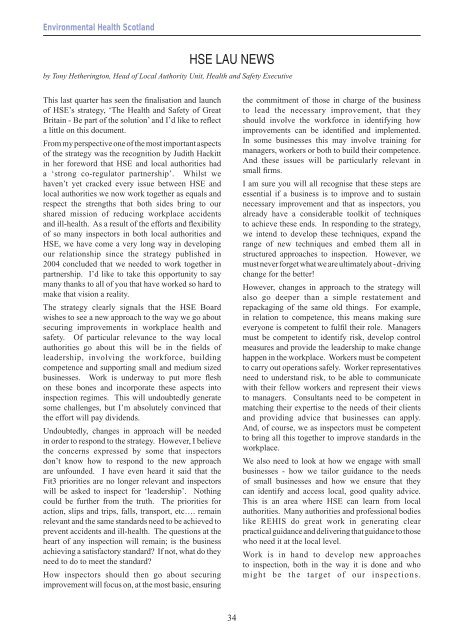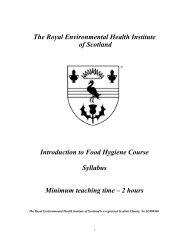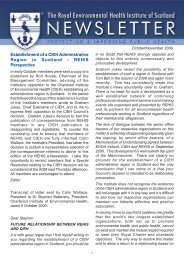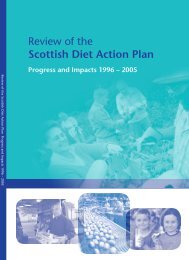Download REHIS Journal 21/3 (Autumn 2009) - The Royal ...
Download REHIS Journal 21/3 (Autumn 2009) - The Royal ...
Download REHIS Journal 21/3 (Autumn 2009) - The Royal ...
You also want an ePaper? Increase the reach of your titles
YUMPU automatically turns print PDFs into web optimized ePapers that Google loves.
Environmental Health Scotland<br />
HSE LAU NEWS<br />
by Tony Hetherington, Head of Local Authority Unit, Health and Safety Executive<br />
This last quarter has seen the finalisation and launch<br />
of HSE’s strategy, ‘<strong>The</strong> Health and Safety of Great<br />
Britain - Be part of the solution’ and I’d like to reflect<br />
a little on this document.<br />
From my perspective one of the most important aspects<br />
of the strategy was the recognition by Judith Hackitt<br />
in her foreword that HSE and local authorities had<br />
a ‘strong co-regulator partnership’. Whilst we<br />
haven’t yet cracked every issue between HSE and<br />
local authorities we now work together as equals and<br />
respect the strengths that both sides bring to our<br />
shared mission of reducing workplace accidents<br />
and ill-health. As a result of the efforts and flexibility<br />
of so many inspectors in both local authorities and<br />
HSE, we have come a very long way in developing<br />
our relationship since the strategy published in<br />
2004 concluded that we needed to work together in<br />
partnership. I’d like to take this opportunity to say<br />
many thanks to all of you that have worked so hard to<br />
make that vision a reality.<br />
<strong>The</strong> strategy clearly signals that the HSE Board<br />
wishes to see a new approach to the way we go about<br />
securing improvements in workplace health and<br />
safety. Of particular relevance to the way local<br />
authorities go about this will be in the fields of<br />
leadership, involving the workforce, building<br />
competence and supporting small and medium sized<br />
businesses. Work is underway to put more flesh<br />
on these bones and incorporate these aspects into<br />
inspection regimes. This will undoubtedly generate<br />
some challenges, but I’m absolutely convinced that<br />
the effort will pay dividends.<br />
Undoubtedly, changes in approach will be needed<br />
in order to respond to the strategy. However, I believe<br />
the concerns expressed by some that inspectors<br />
don’t know how to respond to the new approach<br />
are unfounded. I have even heard it said that the<br />
Fit3 priorities are no longer relevant and inspectors<br />
will be asked to inspect for ‘leadership’. Nothing<br />
could be further from the truth. <strong>The</strong> priorities for<br />
action, slips and trips, falls, transport, etc…. remain<br />
relevant and the same standards need to be achieved to<br />
prevent accidents and ill-health. <strong>The</strong> questions at the<br />
heart of any inspection will remain; is the business<br />
achieving a satisfactory standard? If not, what do they<br />
need to do to meet the standard?<br />
How inspectors should then go about securing<br />
improvement will focus on, at the most basic, ensuring<br />
the commitment of those in charge of the business<br />
to lead the necessary improvement, that they<br />
should involve the workforce in identifying how<br />
improvements can be identified and implemented.<br />
In some businesses this may involve training for<br />
managers, workers or both to build their competence.<br />
And these issues will be particularly relevant in<br />
small firms.<br />
I am sure you will all recognise that these steps are<br />
essential if a business is to improve and to sustain<br />
necessary improvement and that as inspectors, you<br />
already have a considerable toolkit of techniques<br />
to achieve these ends. In responding to the strategy,<br />
we intend to develop these techniques, expand the<br />
range of new techniques and embed them all in<br />
structured approaches to inspection. However, we<br />
must never forget what we are ultimately about - driving<br />
change for the better!<br />
However, changes in approach to the strategy will<br />
also go deeper than a simple restatement and<br />
repackaging of the same old things. For example,<br />
in relation to competence, this means making sure<br />
everyone is competent to fulfil their role. Managers<br />
must be competent to identify risk, develop control<br />
measures and provide the leadership to make change<br />
happen in the workplace. Workers must be competent<br />
to carry out operations safely. Worker representatives<br />
need to understand risk, to be able to communicate<br />
with their fellow workers and represent their views<br />
to managers. Consultants need to be competent in<br />
matching their expertise to the needs of their clients<br />
and providing advice that businesses can apply.<br />
And, of course, we as inspectors must be competent<br />
to bring all this together to improve standards in the<br />
workplace.<br />
We also need to look at how we engage with small<br />
businesses - how we tailor guidance to the needs<br />
of small businesses and how we ensure that they<br />
can identify and access local, good quality advice.<br />
This is an area where HSE can learn from local<br />
authorities. Many authorities and professional bodies<br />
like <strong>REHIS</strong> do great work in generating clear<br />
practical guidance and delivering that guidance to those<br />
who need it at the local level.<br />
Work is in hand to develop new approaches<br />
to inspection, both in the way it is done and who<br />
might be the target of our inspections.<br />
34













